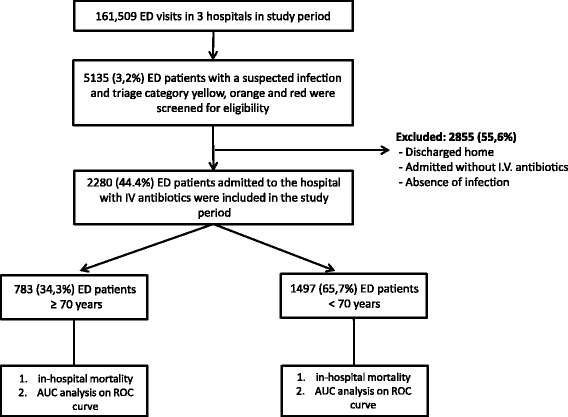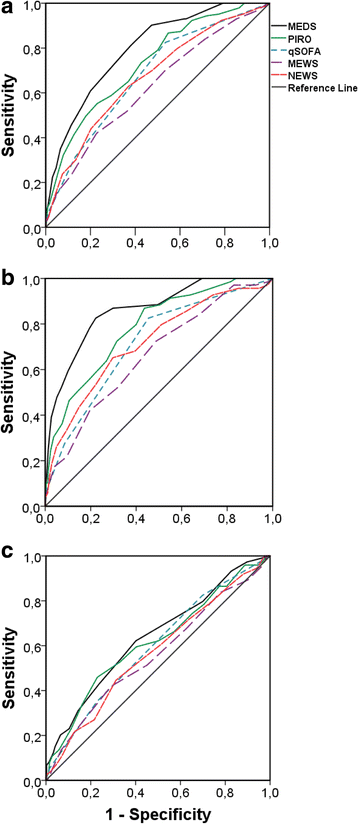The most commonly used disease severity scores are inappropriate for risk stratification of older emergency department sepsis patients: an observational multi-centre study
- PMID: 28893325
- PMCID: PMC5594503
- DOI: 10.1186/s13049-017-0436-3
The most commonly used disease severity scores are inappropriate for risk stratification of older emergency department sepsis patients: an observational multi-centre study
Abstract
Background: Sepsis recognition in older emergency department (ED) patients is difficult due to atypical symptom presentation. We therefore investigated whether the prognostic and discriminative performance of the five most commonly used disease severity scores were appropriate for risk stratification of older ED sepsis patients (≥70 years) compared to a younger control group (<70 years).
Methods: This was an observational multi-centre study using an existing database in which ED patients who were hospitalized with a suspected infection were prospectively included. Patients were stratified by age < 70 and ≥70 years. We assessed the association with in-hospital mortality (primary outcome) and the area under the curve (AUC) with receiver operator characteristics of the Predisposition, Infection, Response, Organ dysfunction (PIRO), quick Sequential Organ Failure Assessment (qSOFA), Mortality in ED Sepsis (MEDS), and the Modified and National Early Warning (MEWS and NEWS) scores.
Results: In-hospital mortality was 9.5% ((95%-CI); 7.4-11.5) in the 783 included older patients, and 4.6% (3.6-5.7) in the 1497 included younger patients. In contrast to younger patients, disease severity scores in older patients associated poorly with mortality. The AUCs of all disease severity scores were poor and ranged from 0.56 to 0.64 in older patients, significantly lower than the good AUC range from 0.72 to 0.86 in younger patients. The MEDS had the best AUC (0.64 (0.57-0.71)) in older patients. In older and younger patients, the newly proposed qSOFA score (Sepsis 3.0) had a lower AUC than the PIRO score (sepsis 2.0).
Conclusion: The prognostic and discriminative performance of the five most commonly used disease severity scores was poor and less useful for risk stratification of older ED sepsis patients.
Keywords: Disease severity scores; Emergency medical services; Infectious diseases; Mortality; Older patients; Risk stratification; Sepsis; qSOFA.
Conflict of interest statement
Ethics approval and consent to participate
The study was approved by the medical ethics committee of the LUMC, who waived the need for individual informed consent as this was a pure observational study.
Consent for publication
Not applicable.
Competing interests
The author(s) declare that they have no competing interests.
Publisher’s Note
Springer Nature remains neutral with regard to jurisdictional claims in published maps and institutional affiliations.
Figures



References
-
- Timothy D, et al. Insights into severe sepsis in older patients: from epidemiology to evidence-based management. Aging Infectious Diseases. 2005;40:719–27. - PubMed
Publication types
MeSH terms
LinkOut - more resources
Full Text Sources
Other Literature Sources
Medical

